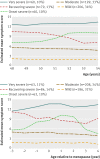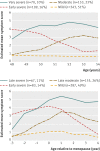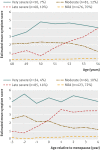Health symptoms during midlife in relation to menopausal transition: British prospective cohort study
- PMID: 22318435
- PMCID: PMC3275131
- DOI: 10.1136/bmj.e402
Health symptoms during midlife in relation to menopausal transition: British prospective cohort study
Abstract
Objective: To characterise symptoms experienced by women during the transition into natural menopause, to classify women into distinct symptom profiles or trajectories, and to relate these profiles to sociodemographic factors and health behaviours.
Design: Nationally representative cohort study.
Setting: England, Scotland, and Wales.
Participants: 695 women followed-up since birth in 1946 and annually from age 47 to 54 who experienced natural menopause and reported on 20 common health symptoms.
Main outcome measure: Longitudinal profiles for reported bothersome symptoms.
Results: Of 20 individual symptoms, 18 formed into four stable symptom groups: psychological, somatic, vasomotor, and sexual discomfort. Using latent class analyses, all except the somatic group of symptoms showed a clear relation with the timing of menopause for some women. A small proportion of women (10%, n=63) had a severe psychological symptom profile that peaked at or in the year after menopause. For vasomotor symptoms, 14% of women (n=83) had the early severe profile that also peaked around early postmenopause and then declined noticeably; 11% (n=67) had the late severe profile of bothersome symptoms that increased rapidly in perimenopause and remained high for four years or more after menopause. Women were less likely to have a profile for severe vasomotor symptoms if they were from a non-manual social class (odds ratio 0.79, 95% confidence interval 0.57 to 1.01) or had degree level qualifications (0.37, 0.18 to 0.77). The 14% of women (n=85) who had the late severe profile for sexual discomfort showed a similar increase in symptoms until menopause, with symptoms persisting after menopause. Married women were more likely to have the late severe or late moderate profile than women of other marital status (2.40, 1.30 to 4.41). Four profiles each were identified for somatic symptoms (mild, moderate, severe, and very severe), although these did not vary by chronological age or age at menopause.
Conclusion: Profiles for psychological, vasomotor, and sexual discomfort symptoms relative to age at menopause could help health professionals to tailor their advice for women with natural menopause.
Conflict of interest statement
Competing interests: All authors have completed the ICMJE uniform disclosure form at
Figures




Comment in
-
Can the severity of menopausal symptoms be predicted?BMJ. 2012 Feb 8;344:d7664. doi: 10.1136/bmj.d7664. BMJ. 2012. PMID: 22318434 No abstract available.
References
-
- Freeman EW, Sherif K. Prevalence of hot flushes and night sweats around the world: a systematic review. Climacteric 2007;10:197-214. - PubMed
-
- NIH. NIH state-of-the science conference statement on management of menopause related symptoms. NIH Consensus and State-of-the-Science Statements, 2005. - PubMed
-
- Col NF, Guthrie JR, Politi M, Dennerstein L. Duration of vasomotor symptoms in middle-aged women: a longitudinal study. Menopause 2009;16:453-7. - PubMed
-
- Hardy R, Kuh D. Change in psychological and vasomotor symptom reporting during the menopause. Soc Sci Med 2002;55:1975-88. - PubMed
Publication types
MeSH terms
Grants and funding
LinkOut - more resources
Full Text Sources
Other Literature Sources
Medical
